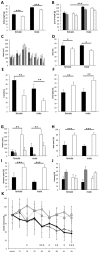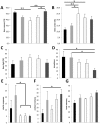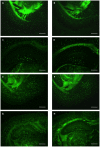Galantamine slows down plaque formation and behavioral decline in the 5XFAD mouse model of Alzheimer's disease
- PMID: 24586789
- PMCID: PMC3931790
- DOI: 10.1371/journal.pone.0089454
Galantamine slows down plaque formation and behavioral decline in the 5XFAD mouse model of Alzheimer's disease
Abstract
The plant alkaloid galantamine is an established symptomatic drug treatment for Alzheimer's disease (AD), providing temporary cognitive and global relief in human patients. In this study, the 5X Familial Alzheimer's Disease (5XFAD) mouse model was used to investigate the effect of chronic galantamine treatment on behavior and amyloid β (Aβ) plaque deposition in the mouse brain. Quantification of plaques in untreated 5XFAD mice showed a gender specific phenotype; the plaque density increased steadily reaching saturation in males after 10 months of age, whereas in females the density further increased until after 14 months of age. Moreover, females consistently displayed a higher plaque density in comparison to males of the same age. Chronic oral treatment with galantamine resulted in improved performance in behavioral tests, such as open field and light-dark avoidance, already at mildly affected stages compared to untreated controls. Treated animals of both sexes showed significantly lower plaque density in the brain, i.e., the entorhinal cortex and hippocampus, gliosis being always positively correlated to plaque load. A high dose treatment with a daily uptake of 26 mg/kg body weight was tolerated well and produced significantly larger positive effects than a lower dose treatment (14 mg/kg body weight) in terms of plaque density and behavior. These results strongly support that galantamine, in addition to improving cognitive and behavioral symptoms in AD, may have disease-modifying and neuroprotective properties, as is indicated by delayed Aβ plaque formation and reduced gliosis.
Conflict of interest statement
Figures







Similar articles
-
Nasal Application of the Galantamine Pro-drug Memogain Slows Down Plaque Deposition and Ameliorates Behavior in 5X Familial Alzheimer's Disease Mice.J Alzheimers Dis. 2015;46(1):123-36. doi: 10.3233/JAD-142421. J Alzheimers Dis. 2015. PMID: 25720404
-
Early administration of galantamine from preplaque phase suppresses oxidative stress and improves cognitive behavior in APPswe/PS1dE9 mouse model of Alzheimer's disease.Free Radic Biol Med. 2019 Dec;145:20-32. doi: 10.1016/j.freeradbiomed.2019.09.014. Epub 2019 Sep 16. Free Radic Biol Med. 2019. PMID: 31536772
-
Caffeoylquinic Acid Mitigates Neuronal Loss and Cognitive Decline in 5XFAD Mice Without Reducing the Amyloid-β Plaque Burden.J Alzheimers Dis. 2024;99(4):1285-1301. doi: 10.3233/JAD-240033. J Alzheimers Dis. 2024. PMID: 38788074
-
Update on Alzheimer drugs (galantamine).Neurologist. 2003 Sep;9(5):235-40. doi: 10.1097/01.nrl.0000087722.46430.c4. Neurologist. 2003. PMID: 12971834 Review.
-
Pharmacological and molecular enhancement of learning in aging and Alzheimer's disease.J Physiol Paris. 2006 Mar-May;99(2-3):180-92. doi: 10.1016/j.jphysparis.2005.12.079. Epub 2006 Feb 3. J Physiol Paris. 2006. PMID: 16458491 Review.
Cited by
-
Review of Advanced Drug Trials Focusing on the Reduction of Brain Beta-Amyloid to Prevent and Treat Dementia.J Exp Pharmacol. 2022 Oct 30;14:331-352. doi: 10.2147/JEP.S265626. eCollection 2022. J Exp Pharmacol. 2022. PMID: 36339394 Free PMC article. Review.
-
Acetylcholinesterase Inhibitors in the Treatment of Neurodegenerative Diseases and the Role of Acetylcholinesterase in their Pathogenesis.Int J Mol Sci. 2021 Aug 27;22(17):9290. doi: 10.3390/ijms22179290. Int J Mol Sci. 2021. PMID: 34502198 Free PMC article. Review.
-
Promotion of neuroinflammation in select hippocampal regions in a mouse model of perimenopausal Alzheimer's disease.Front Mol Biosci. 2025 May 14;12:1597130. doi: 10.3389/fmolb.2025.1597130. eCollection 2025. Front Mol Biosci. 2025. PMID: 40438709 Free PMC article.
-
Lipidomic Network Analysis Reveals Amyloid-β-Induced Lysosomal Lipid Accumulation in the Cortex and Hippocampus of 5xFAD Mice.J Proteome Res. 2025 Jul 4;24(7):3389-3398. doi: 10.1021/acs.jproteome.4c01133. Epub 2025 Jun 24. J Proteome Res. 2025. PMID: 40552726 Free PMC article.
-
Nanotechnology to improve the Alzheimer's disease therapy with natural compounds.Drug Deliv Transl Res. 2020 Apr;10(2):380-402. doi: 10.1007/s13346-019-00694-3. Drug Deliv Transl Res. 2020. PMID: 31773421 Review.
References
-
- Karran E, Mercken M, De Strooper B (2011) The amyloid cascade hypothesis for Alzheimer’s disease: an appraisal for the development of therapeutics. Nat Rev Drug Discov 10: 698–712. - PubMed
-
- Citron M (2004) Strategies for disease modification in Alzheimer’s disease. Nat Rev Neurosci 5: 677–685. - PubMed
Publication types
MeSH terms
Substances
LinkOut - more resources
Full Text Sources
Other Literature Sources
Medical
Molecular Biology Databases

